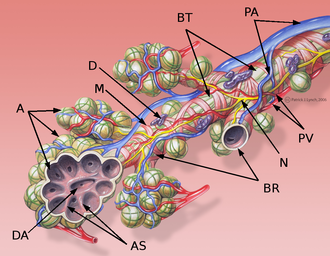Pulmonary alveolus: Difference between revisions
CSV import |
No edit summary |
||
| (3 intermediate revisions by the same user not shown) | |||
| Line 1: | Line 1: | ||
[[File:Alveolus_diagram.svg|thumb|right|Diagram of a pulmonary alveolus.]] | |||
The '''pulmonary alveolus''' (plural: alveoli, from Latin alveolus, "little cavity") is a hollow cavity found in the [[lung]]s, and is the basic unit of [[respiration]]. The alveoli are the endpoint of the [[respiratory tree]], which includes the [[trachea]], [[bronchi]], and [[bronchioles]]. | |||
== | == Structure == | ||
[[File:Bronchial_anatomy_with_description.png|thumb|left|Anatomy of the bronchial tree leading to the alveoli.]] | |||
== | The alveoli are tiny, balloon-shaped structures and are the smallest passageway in the respiratory system. They are arranged in clusters throughout the lungs, with each cluster known as an [[alveolar sac]]. The walls of the alveoli are extremely thin, allowing for efficient [[gas exchange]] with the [[capillaries]] that surround them. | ||
* [[ | |||
=== Alveolar Cells === | |||
The alveolar walls are composed of two types of cells: | |||
* '''Type I alveolar cells''': These are thin and flat cells that form the structure of the alveolar wall. | |||
* '''Type II alveolar cells''': These cells secrete [[surfactant]], a substance that reduces surface tension and prevents the alveoli from collapsing. | |||
== Function == | |||
[[File:Cross_section_of_an_alveolus_and_capillaries_showing_diffusion_of_gases.svg|thumb|right|Cross-section of an alveolus showing gas exchange.]] | |||
The primary function of the alveoli is to exchange oxygen and carbon dioxide molecules to and from the bloodstream. This process is known as [[gas exchange]]. Oxygen from the inhaled air diffuses through the walls of the alveoli and into the blood in the capillaries, while carbon dioxide from the blood diffuses into the alveoli to be exhaled. | |||
== Gas Exchange Process == | |||
[[File:Gas_exchange_in_the_aveolus.svg|thumb|left|Diagram showing gas exchange in the alveolus.]] | |||
Gas exchange occurs by [[diffusion]], a process driven by the concentration gradients of the gases. Oxygen, which is more concentrated in the alveoli than in the blood, diffuses into the blood, while carbon dioxide, which is more concentrated in the blood, diffuses into the alveoli. | |||
== Clinical Significance == | |||
[[File:Cryptococcosis_of_lung_in_patient_with_AIDS._Mucicarmine_stain_962_lores.jpg|thumb|right|Cryptococcosis infection in the lung.]] | |||
Diseases affecting the alveoli can severely impact respiratory function. Conditions such as [[pneumonia]], [[emphysema]], and [[pulmonary fibrosis]] can damage the alveoli, leading to impaired gas exchange. Infections like [[cryptococcosis]] can also affect the alveoli, particularly in immunocompromised individuals. | |||
== | == Related Pages == | ||
* [[Lung]] | |||
* [[Respiratory system]] | |||
* [[Gas exchange]] | |||
* [[Surfactant]] | |||
{{Lung}} | |||
{{DEFAULTSORT:Pulmonary Alveolus}} | |||
[[Category:Anatomy]] | [[Category:Anatomy]] | ||
[[Category:Lung anatomy]] | |||
[[Category:Respiratory system anatomy]] | |||
[[Category:Respiratory system]] | [[Category:Respiratory system]] | ||
Latest revision as of 00:59, 26 February 2025

The pulmonary alveolus (plural: alveoli, from Latin alveolus, "little cavity") is a hollow cavity found in the lungs, and is the basic unit of respiration. The alveoli are the endpoint of the respiratory tree, which includes the trachea, bronchi, and bronchioles.
Structure[edit]

The alveoli are tiny, balloon-shaped structures and are the smallest passageway in the respiratory system. They are arranged in clusters throughout the lungs, with each cluster known as an alveolar sac. The walls of the alveoli are extremely thin, allowing for efficient gas exchange with the capillaries that surround them.
Alveolar Cells[edit]
The alveolar walls are composed of two types of cells:
- Type I alveolar cells: These are thin and flat cells that form the structure of the alveolar wall.
- Type II alveolar cells: These cells secrete surfactant, a substance that reduces surface tension and prevents the alveoli from collapsing.
Function[edit]

The primary function of the alveoli is to exchange oxygen and carbon dioxide molecules to and from the bloodstream. This process is known as gas exchange. Oxygen from the inhaled air diffuses through the walls of the alveoli and into the blood in the capillaries, while carbon dioxide from the blood diffuses into the alveoli to be exhaled.
Gas Exchange Process[edit]

Gas exchange occurs by diffusion, a process driven by the concentration gradients of the gases. Oxygen, which is more concentrated in the alveoli than in the blood, diffuses into the blood, while carbon dioxide, which is more concentrated in the blood, diffuses into the alveoli.
Clinical Significance[edit]

Diseases affecting the alveoli can severely impact respiratory function. Conditions such as pneumonia, emphysema, and pulmonary fibrosis can damage the alveoli, leading to impaired gas exchange. Infections like cryptococcosis can also affect the alveoli, particularly in immunocompromised individuals.
Related Pages[edit]
| Anatomy of the lower respiratory tract | ||||||||||||
|---|---|---|---|---|---|---|---|---|---|---|---|---|
|